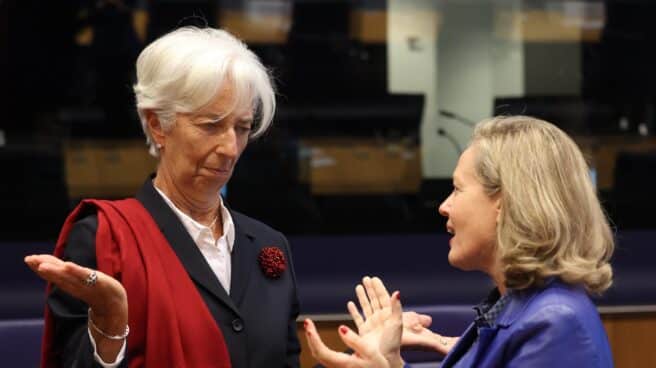

European Central Bank President Christine Lagarde, along with Spanish Economy Minister Nadia Calvinho, this afternoon at the Eurogroup meeting in Luxembourg.
The Government has already presented the General State Budget for 2023. Total for the next year 485 986 million euros. This figure is based on forecasts and a number of possible economic risks. One such risk is monetary policy. Nonetheless, The executive branch is minimizing the impact of stronger rate hikes in the eurozone.
The government believes that an increase in the interest rate hike in 2023 is one of the risks that exist in order for the noted forecasts, and therefore the budget revenues and expenditures, not to be fulfilled in the form in which they were presented this Thursday. In a scenario of stronger or more sustained price growth than envisaged by the European Central Bank, monetary authorities may take on a more restrained tone than expected, an increase in the pace or intensity of interest rate increases, which will reduce economic growth driven by investment and consumption in 2023, they note in a report submitted to Congress.
However, in the same report they explain that the Spanish economy is now less exposed to tighter monetary conditions than in the previous cycle of restrictive monetary policy, “given that private debt has fallen significantly from levels in the past and a period of low interest rates has been used to improve the financing conditions for Spain’s public debt.”
The European Central Bank (ECB) has changed its discourse and become more aggressive (“hawkish”). Since July last year, its monetary policy has become restrictive, with rate hikes after eleven years. Thus, at the first meeting, the price of money was raised by 50 basis points, and at the September meeting, she made a historic move: she raised rates by 75 basis points. So the price of money is now 1.25%. Experts say growth will continue this year and next.
The Spanish economy is currently less exposed to monetary tightening.
On the other hand, the executive branch also points out that the reduction in non-tax revenues is due, among other things, to a decrease in income from share premiums as a result of higher interest rates. “In this sense, it should be remembered that these revenues depend on the release of extensions of past releases to the market at higher rates than the current ones, which has been a characteristic situation in recent years,” they explain. The fact that the stakes are currently rising makes the games of yesteryear less attractive and therefore reduces the possibility of earning income in this way. In fact, they claim that this decline has already been observed so far this year: by July, these revenues had fallen by more than 46%.
A few months ago, Economy Minister Nadia Calvinho assured that Spain and the State Treasury were ready to normalize monetary policy. Thus, the public debt of Spain does not represent risks. Calvinho says that “only 15% of the Spanish debt portfolio is subject to higher interest rates, as it needs to be refinanced this year.”
The public debt program for 2022 provides for gross issuance of 237,498 million euros. thus, a refinancing of 15% would mean around 35,624 million euros.. The Vice President wanted to move away from the debt crisis scenario because the average level of outstanding outstanding debt is below 1.6%, given that the State Treasury has achieved “historic elongation” an average debt maturity of up to eight years and “virtually 60% of the financing program planned for this year has been completed.”
Source: El Independiente